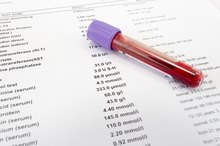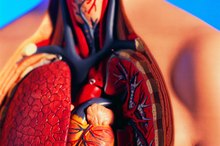Venipuncture Methods
Venipuncture is the process of piercing a vein with a needle to withdraw blood or start an intravenous line for giving medications. Venipuncture is often performed so blood can be tested for a variety of medical reasons and conditions. The phlebotomist, or professional who draws blood, prepares a patient by choosing a vein; applying a tourniquet, or tight band, to slow blood flow in the chosen vein; and cleansing skin over the vein to prevent infection. She then chooses a venipuncture method most appropriate for the patient.
Syringe Method
The syringe method of venipuncture is beneficial when small amounts of blood need to be drawn or when a patient has small or fragile veins, according to Kathryn Kalanick in her book Phlebotomy Technician Specialist: A Practical Guide to Phlebotomy. Venipuncture syringes are composed of a plastic syringe with an attached, beveled needle. Both the syringe and needle are available in varying sizes. The needle is inserted into a prepared vein. Suction is created to draw blood out of the vein by pulling back gently, slowly and steadily on the syringe plunger.
The needle is withdrawn from the patient’s arm after the desired amount of blood has been collected in the syringe. The needle is then placed into the rubber stopper of a collection tube that contains powder or gel to prevent the blood from clotting. Blood is transferred from the syringe into the collection tube by slowly pressing down on the plunger.
- The syringe method of venipuncture is beneficial when small amounts of blood need to be drawn or when a patient has small or fragile veins, according to Kathryn Kalanick in her book Phlebotomy Technician Specialist: A Practical Guide to Phlebotomy.
- Suction is created to draw blood out of the vein by pulling back gently, slowly and steadily on the syringe plunger.
Vacuum Tube Method
Vacutainer Advantages & Disadvantages
Learn More
Vacuum tubes are glass tubes with rubber stoppers that contain anti-coagulating gel or powder to prevent blood from clotting in the tube. The vacuum tube method of phlebotomy is good for collecting multiple vials of blood, come in multiple sizes and is often used for routine blood draws.
Vacuum collection sets include a double-pointed needle, a plastic tube holder and vacuum collection tube. The double-pointed needle is inserted into the plastic holder. One end of the double-pointed needle pierces the vein and the other enters the rubber top of the vacuum collection tube. Blood is drawn into the collection tube from the vacuum inside the tube. Filled vacuum collection tubes can be removed and a new one added as needed until the desired amount of blood has been collected.
- Vacuum tubes are glass tubes with rubber stoppers that contain anti-coagulating gel or powder to prevent blood from clotting in the tube.
- One end of the double-pointed needle pierces the vein and the other enters the rubber top of the vacuum collection tube.
Butterfly Method
The California Association for Medical Laboratory Technology states that the butterfly method is most appropriate for patients who have difficult veins to access, such as cancer patients, the elderly and children 3. The butterfly, or winged, method includes a very small needle attached to a rigid plastic piece that contains flexible plastic ‘wings’ on either side. The wings are brought up into a triangle above the needle. The phlebotomist grasps the triangle for better control of the small needle. Flexible plastic tubing is attached to the winged portion of the collection, set which is then attached to either a syringe or vacuum tube for collecting blood.
- The California Association for Medical Laboratory Technology states that the butterfly method is most appropriate for patients who have difficult veins to access, such as cancer patients, the elderly and children 3.
- Flexible plastic tubing is attached to the winged portion of the collection, set which is then attached to either a syringe or vacuum tube for collecting blood.
Related Articles
References
- “Delmar’s Clinical Medical Assisting”; Wilburta Lindh, et al; 2010
- Eastfield College: Phlebotomy Technician Certification
- Venipuncture Technique. In: Sedation. 6th edition. 2018:308-318. doi:10.1016/b978-0-323-40053-4.00024-x
- Ohnishi H, Watanabe M, Watanabe T. Butterfly needles reduce the incidence of nerve injury during phlebotomy. Arch Pathol Lab Med. 2012;136(4):352. doi:10.5858/arpa.2011-0431-LE
- Ialongo, C. and Bernardini, S. Phlebotomy, a bridge between laboratory and patient. Biochem Med (Zagreb). 2016 Feb 15;26(1):17-33. DOI: 10.11613/BM.2016.002.
- Wolowitz, A.; Bijur, P.; Esses, D. et al. Use of Butterfly Needles to Draw Blood Is Independently Associated With Marked Reduction in Hemolysis Compared to Intravenous Catheter. Society for Academic Emergency Medicine Annual Meeting; Atlanta, Georgia; May 2013. DOI: 10.1111/acem.12245.
Writer Bio
Elizabeth Otto has been writing professionally since 2003. She is a licensed emergency medical technician-intermediate with over 10 years of experience in the field. She has worked as a clinical assistant in family health and emergency medicine since 1995. Otto is a freelance writer for various websites and holds an Associate of Science in medical assisting from Commonwealth College.







